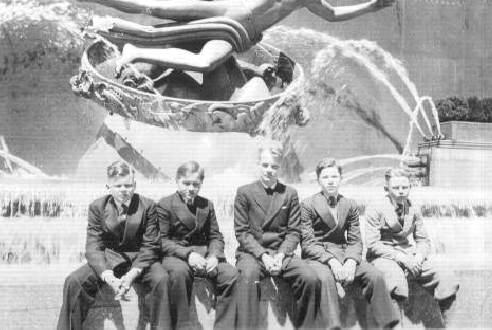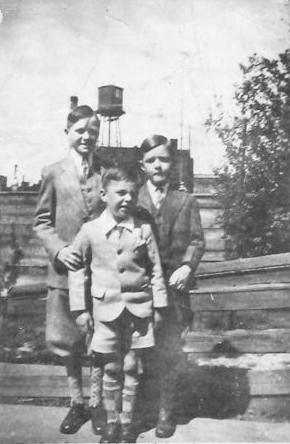
United States Boys' Suits Chronology: The 1930s

Figure 1.--This snapshot show five younger teengers seated in front of 'Promethius' fountain at Rockefeller Center, New York City. The date on the back was September 11 1937. The location and suits suggest the boys came from prosperous families. Notice the boys are wearing double-breasted jackets, but only one boy wears knickers. Knickers after the mid-30s declined sharply in popularity.
|
|
American boys were still commonly wearing suits at the beginning of the decade, but not nearly as commonly as in the 1930s. Boys wore suits to church and specialy occassions, but increasingly casual wear was becoming common for a wide range of ocassion, including school. This can clearly be seen in the photoraphic record. A good way to assess this is school portraits. Younger boys might wear Eton suits in the 1930s, often with short pants. Some had matching caps. This style was most popular among affluent families. We note older boys wearing both single- and double-breasted jackets. This was the last decade that the double-breasted jacket was a major style for boys. We see sports jackets beginning to become popular. We see boys wearing short pants, knickers, and long pants suits. Knickers suits were still common in the early-30s. They were worn less with long stockings as brightly patterened knee socks became popular. We see thesev lou knee socks with conservative suits. This is destinctively American. We do not see anything like this in Europe. After mid-decade we begin to see more boys wearing long pants suits. Some boys wore short pants suits, mostly younger boys. There was also a social-claas element. Short pants suits were more common with affluent Americans than knicker suits. By the end of the decade, knicker suits were rapidly going out of style. Suits overall were declining in popularity. They were no longer commonlt worn to school except at some private schools. We also see them in secodary schools.
Prevalence
Suits overall were declining in popularity during the 1930s. They were no longer commonly worn to elementary (primary) school, although there ws sime variatin from school to school. An exception was some private schools. And we see fewer boys wearing suits to secondary schools. Here age was a factor. We see some older boys at secodary schools wearing suits. This declining usage of suits was a continuing process throughout the decade. This can be observed in the HBC 1930s school section.
Conventions
American boys were still commonly wearing suits at the beginning of the decade, but not nearly as commonly as in the 1930s. Boys wore suits to church and specialy occassions, but increasingly casual wear was becoming common for a wide range of ocassion, including school. This can clearly be seen in the photoraphic record.
Jackets
Younger boys might wear Eton suits in the 1930s. Theywere often done with short pants. We also se long pant, but rarely knickers for some reason. We see boys up to about 10-years ofage wearing these Eton jackets. This varied from family to family. Here us a good example in 1930 (figure 2). Some had matching caps. This style was most popular among affluent families. We note older boys wearing both single- and double-breasted jackets. This was the last decade that the double-breasted jacket was a major style for boys. We see sports jackets beginning to become popular. They were almost always worn with long pants, probably sports jackets were more of a teen-age style.
Vests
We note far fewer boys wearing suits with vests durng the 1930s. This seems part of the declining prevalence of suits. .
We see boys wearing short pants, knickers, and long pants suits during the 1930s. It was perhaps the most diverse decade for boy's suit trousers. Knicker suits were standard for boys in the 1920s, not as common as in the 1910s or older boys, but still standard. This began to change in the 30s. Knickers suits were still common in the early-30s. After mid-decade, however, we begin to see more boys wearing long pants suits. Some boys wore short pants suits, mostly younger boys. The cut off point for short pants suits was about 10 years of age, but this varied somewhat. This varied from family to family. Some suits came with both knickers and long pants. We are not sure what conventions parents had in mind with this combination. There was also a social-class element with short pants. Short pants suits in additioThe choice of panrs does not seem to have ben seasonal. n to the agedifferential seem more common with affluent Americans than knicker or long pants suits. By the end of the decade, knicker suits were rapidly going out of style, but we still see quite a few in the photographic record. The dominant trend during the decade was the increasing prevalence of long pants, including long pants suits.

Figure 2.--Here we see three unidentified brothers in 1930. Notice the younger brother wears an Eton shirt pants suits, The older brother wears knickers. We are not sure about the middle brother. the boys wear the patterned knee socks that appeared in the late-1920s. Also note the low-cut oxford shoes..
|
|
Hosiery
Hosiery varied with the type of pants worn with suits. Both knee pants and knicker suits were worn with long stickings, mostly blacl long stockings (1890s-1920s). This only begn to change in thelate-20s. Sudenly patterned knee socks became popupar (about 1928). Knicker suits by the earoy-30s were worn less with long stockings as brightly patterened knee socks became standard. We see these loud knee socks even with conservative suits. This is destinctively an American fashion. We do not see anything like this in Europe. Boys except when going barefoot almost always wore knickers with hosiery, long stockings in the 1920s and knee socks in the 1930s. We note boys wearing knickers with ankle socks by the end of the decade. Long stockings had declined in usage abd knee socks were bcoming uppopular with boys, especially during the summer. This seems more common with boys wearing knickers, but not as part of a suit, bur we also see boys wearing knicker suits with ankle socks. Ankle socks were becoming standard for boys and girls were also wearing them. Dark ankle socks with colored bands were the most common.
Footwear
Footwear often changed in the 1930s. High-top shoes disappeared except for todlers. Leather low cut ixfords becane standard for boys and wre also worn by girls, often for chool. Sneakers continued to be worn, but mostly as summer playtime wear.
HBC

Navigate the Boys' Historical Clothing Web Site:
[Return to the Main U.S. 20th century cronology page]
[Introduction]
[Activities]
[Biographies]
[Chronology]
[Clothing styles]
[Countries]
[Bibliographies]
[Contributions]
[FAQs]
[Glossary]
[Images]
[Links]
[Registration]
[Tools]
[Boys' Clothing Home]
Created: 5:21 AM 5/21/2009
Last updated: 6:46 PM 2/9/2015




